Components & Functionality
Programmable Logic Controllers (PLCs)
Programmable Logic Controllers (PLCs) are a key component of most industrial infrastructure. They not only enable flexible programming of machine controls and process automation but also serve as a source of process data and communicate directly with higher-level systems. Learn how a PLC works and discover examples of commonly used controllers.
Definition
What is a Programmable Logic Controller (PLC)?
A Programmable Logic Controller (PLC) is a device used for the automated control and regulation of machines or systems.
It features inputs and outputs, an operating system, and an interface for loading a user program. This user program defines how output signals are determined based on input signals, thereby providing the control logic.
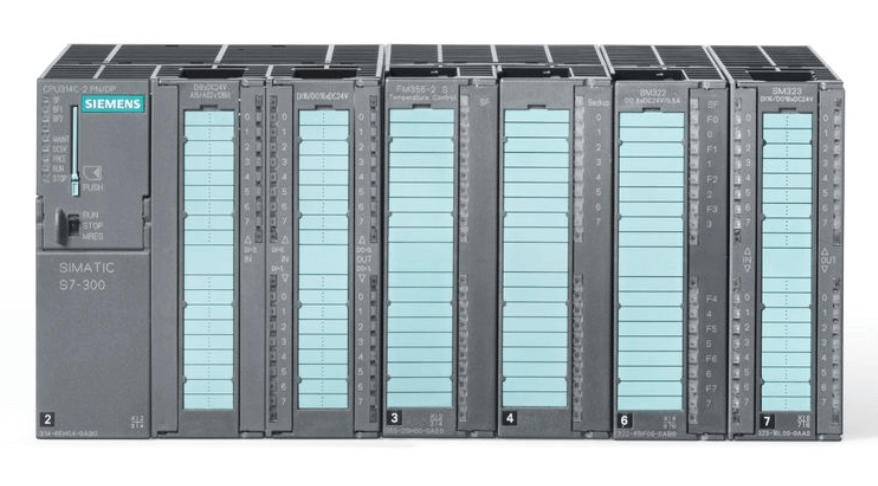
SIMATIC S7-300 – A classic PLC by Siemens
What makes a Programmable Logic Controller special is that the user program can be individually programmed, easily adapted, and reused across multiple controllers. This makes the PLC significantly more flexible than its predecessors – control systems that required fixed wiring and had to be manually modified for any changes.
Today, programmable logic controllers are used almost everywhere in industry. In addition to automated system control, they are also used for collecting process data.
Functionality
How does a Programmable Logic Controller (PLC) work?
System control
The control of systems using a PLC is carried out through sensors and actuators.
Sensors are connected to the PLC’s inputs and transmit measurements such as temperature, fill level, or the status of a switch to the PLC. A PLC can have both digital and analog inputs.
Actuators are connected to the PLC’s outputs and convert the PLC’s output signals into physical actions (e.g. switching on a motor, opening a solenoid valve or activating a signal light).
During operation, the PLC reads the state of its inputs and, based on its user program, determines the appropriate output signals. By updating the outputs, the machine is controlled accordingly.
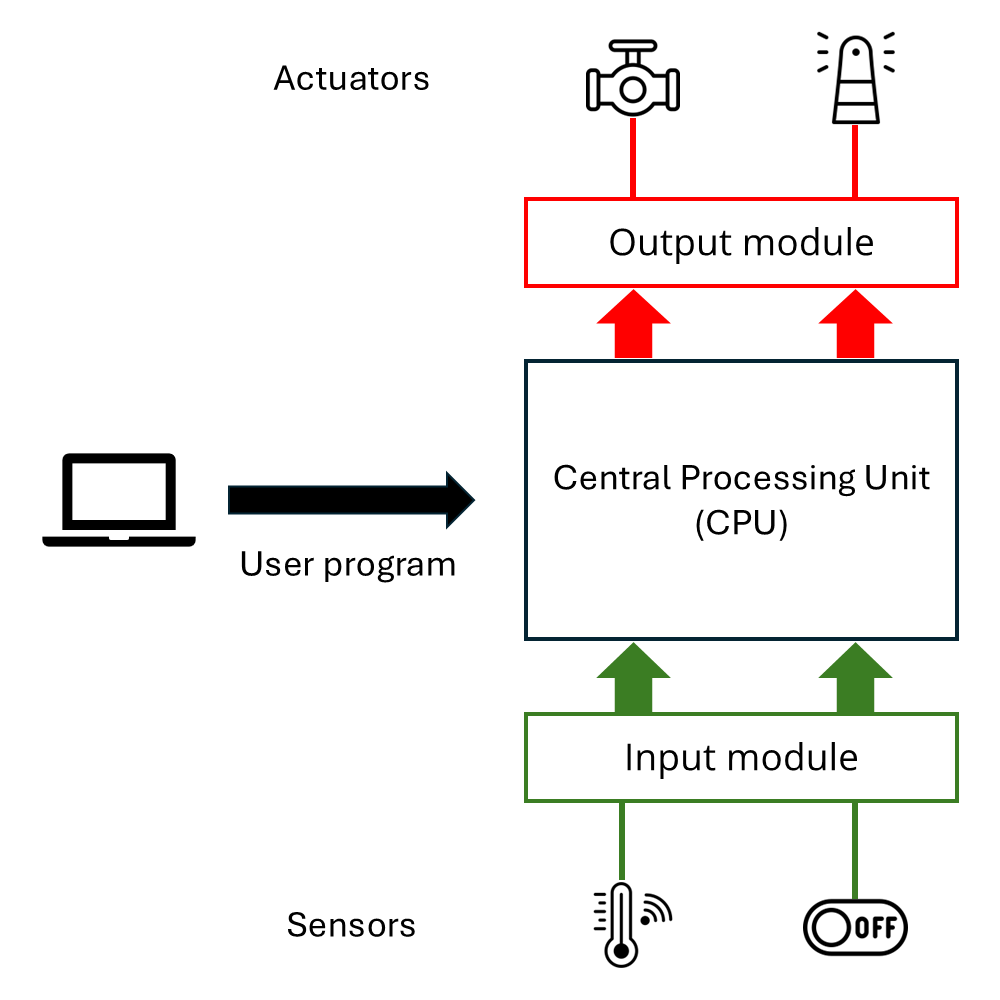
Functionality of a Programmable Logic Controller (PLC) in system control
Data collection and communications
In addition to their primary control function, programmable logic controllers often perform a range of additional tasks.
One such function is the recording of process data, operating states, production quantities, malfunctions, and similar information. This data can be stored locally or transmitted to central systems for analysis.
In modern industry, PLCs serve as an important source of business-relevant data. The collected information is primarily used to monitor and optimize processes, but also supports documentation and traceability.
In practice, PLCs are frequently connected to production-related systems such as SCADA or MES. They can also communicate directly with cloud platforms such as manubes.
To interface with other systems, especially modern PLCs support specific industrial communication protocols. Examples include:
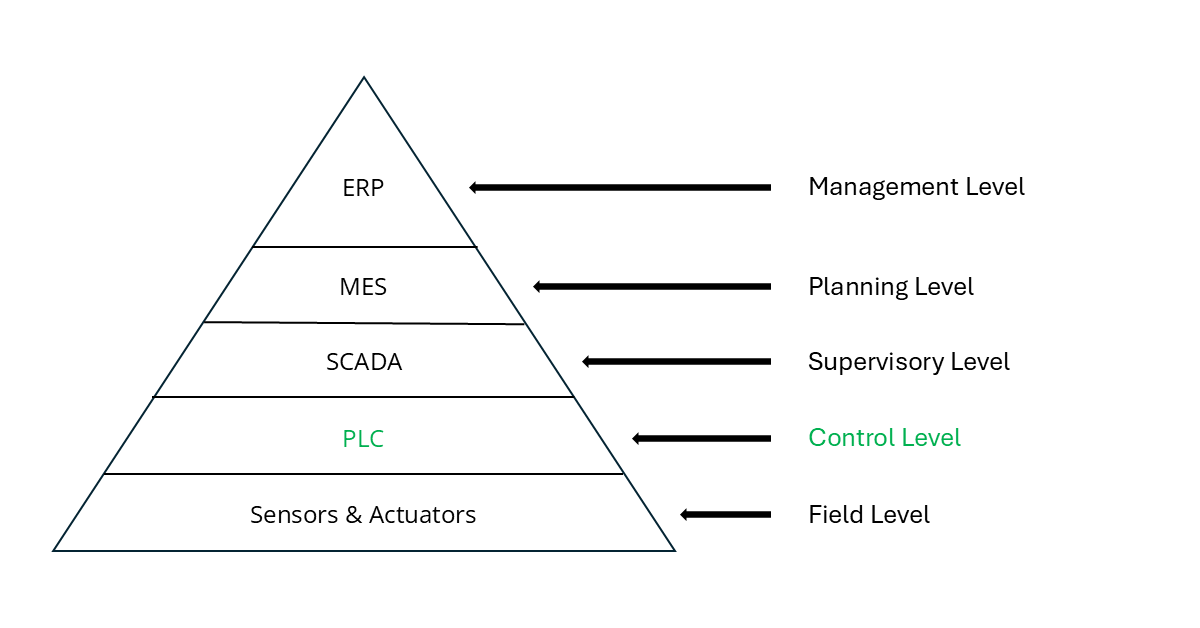
In the traditional automation pyramid, the PLC is positioned at the control level. Today, the boundaries are increasingly blurred, and PLCs often communicate directly with higher levels, including cloud platforms.

manubes connects PLCs and other production system to a central cloud platform. Organize your production data, create custom dashboards for production monitoring and automate tasks with the help of workflows.
Components
What are the components of a Programmable Logic Controller (PLC)?
Programmable Logic Controllers exist in various forms:
- Compact PLC / Standalone Device: Inputs and outputs (I/O), CPU, and interfaces are integrated into a single housing
- Modular PLC: Consists of combinable modules (I/O, CPU, communication modules, etc.)
- Soft PLC: PLC logic runs on a PC and is controlled via software
Compact PLCs are best suited for smaller automation tasks (e.g. pump control), whereas modular and software-based PLCs are used where greater flexibility and performance are required (e.g. complex production lines with many sensors and robots).
Advantages
What are the advantages of a Programmable Logic Controller (PLC)?
Compared to traditional hardwired control systems, the PLC offers a range of technical and economic advantages. These benefits have led to the widespread adoption of PLCs over other control systems, making them a well-established device in industry for decades.
Flexibility and
time-efficient programming
Program changes in a PLC can be made relatively easily by adjusting the digital user program. Unlike with hardwired control systems, no rewiring is necessary. This makes the PLC ideal for environments with changing production requirements.
Reusability of
user programs
User programs that have been used once can be copied, adapted, and reused. Reusable function blocks and libraries enable rapid commissioning of new devices with the same or similar configurations.
Reusability of user programs
User programs that have been used once can be copied, adapted, and reused. Reusable function blocks and libraries enable rapid commissioning of new devices with the same or similar configurations.
Modularity and scalability
Modular PLCs can be expanded with additional modules, including extra inputs and outputs as well as interfaces for communication with other systems. This allows the control system to be adapted to increased requirements. At the same time, using standardized modules offers scalability benefits and improves the availability of spare parts.
Simplified maintenance and diagnostics
Modern PLCs offer functions for visualizing messages and statuses, generating alerts, and recording process data. The ability for remote access and integration into centralized control and monitoring software also simplifies maintenance, troubleshooting, and configuration processes.
Simplified maintenance and diagnostics
Modern PLCs offer functions for visualizing messages and statuses, generating alerts, and recording process data. The ability for remote access and integration into centralized control and monitoring software also simplifies maintenance, troubleshooting, and configuration processes.
Examples of different Programmable Logic Controllers (PLCs)
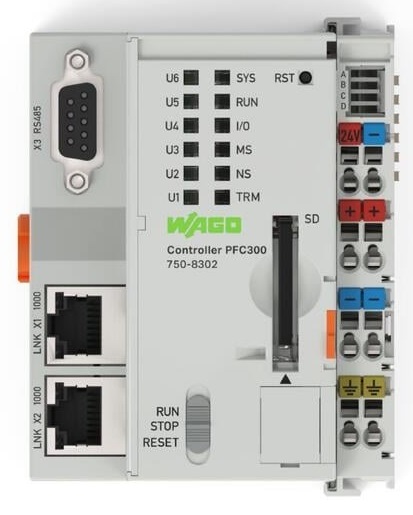
WAGO PFC300
The WAGO PFC300 is a high-performance controller designed for medium to large applications and larger volumes of data. It features serial, Ethernet, and USB interfaces, along with an open architecture that includes Docker compatibility and support for industrial standard protocols.
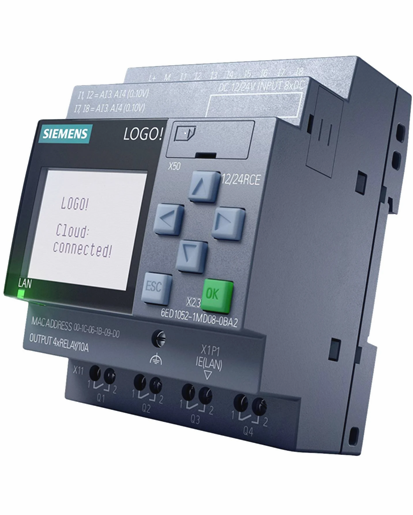
Siemens LOGO!
LOGO! is a compact controller from Siemens with native support for multiple cloud platforms, MQTT, and email functionality. This makes it well-suited for smaller automation tasks and resource-efficient cloud integration.
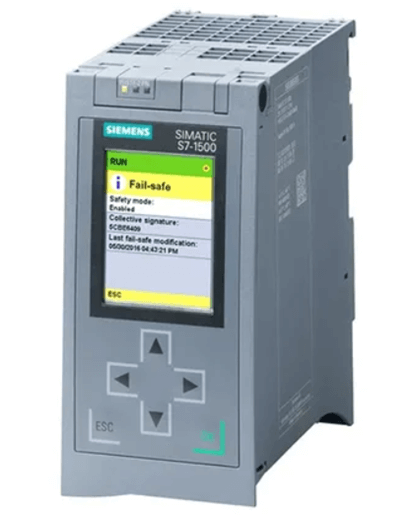
SIMATIC S7-1500
The SIMATIC S7-1500 is a modular PLC from Siemens’ S7 series, designed with a focus on high performance. It can be expanded with various types of modules to meet specific requirements, including additional interfaces and processing power.

WAGO PFC300
The WAGO PFC300 is a high-performance controller designed for medium to large applications and larger volumes of data. It features serial, Ethernet, and USB interfaces, along with an open architecture that includes Docker compatibility and support for industrial standard protocols.

Siemens LOGO!
LOGO! is a compact controller from Siemens with native support for multiple cloud platforms, MQTT, and email functionality. This makes it well-suited for smaller automation tasks and resource-efficient cloud integration.

SIMATIC S7-1500
The SIMATIC S7-1500 is a modular PLC from Siemens’ S7 series, designed with a focus on high performance. It can be expanded with various types of modules to meet specific requirements, including additional interfaces and processing power.

WAGO PFC300
The WAGO PFC300 is a high-performance controller designed for medium to large applications and larger volumes of data. It features serial, Ethernet, and USB interfaces, along with an open architecture that includes Docker compatibility and support for industrial standard protocols.

Siemens LOGO!
LOGO! is a compact controller from Siemens with native support for multiple cloud platforms, MQTT, and email functionality. This makes it well-suited for smaller automation tasks and resource-efficient cloud integration.

SIMATIC S7-1500
The SIMATIC S7-1500 is a modular PLC from Siemens’ S7 series, designed with a focus on high performance. It can be expanded with various types of modules to meet specific requirements, including additional interfaces and processing power.
Try manubes for free
Try the different manubes features in your personal cloud environment.
